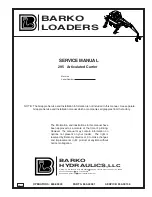
Appendix A – Maintenance and Troubleshooting
2002938-002E
Cardiolab® II Plus Amplifier Manual
A-7
If changing the patch does not help, swap the suspected limb lead
with any of the other lead wires. For example, if Lead I is clean, and
all other signals are noisy, swap the LL with a V wire.
Ensure that all patches on the patient are of the same type. Do not
use different types of patches because this will cause the Common
Mode Rejection Ratio (CMRR) to decrease, producing more noise.
In some cases, an abnormally high soft scale value in the study
configuration can lead to noise. You can reduce this setting by one
level and adjust your signal gains accordingly. For example, if you
move from 1/4 to 1/8, you will have to increase the gain of your
signals by 2 (for example, from 500 to 1000). Values of 1/8 or less are
recommended.
Select hardware reset from the amplifier test window.
Ensure that neither the amplifier nor the computer/IEB is plugged
into an emergency AC power outlet. While these may have good
power, they may introduce noise into CardioLab due to the many
extraneous circuits tied to them. Also, make sure the amplifier is not
plugged into a power strip. The amplified should always be plugged
into its own dedicated outlet.
Install a harmonic filter isolation transformer between the power
source and the amplifier to further reduce noise.
It may be necessary to replace the ECG cable (the cable from the
front oh the amplifier to the limb leads).
Ensure that all AC outlets which CardioLab interfaces with are
properly grounded. To ensure this, a receptacle tester should be used
to look for these wiring faults.
When testing for these problems, remember that auxiliary
equipment such as RF pads and pulse oximeters may be adding noise
to the patient. Therefore, remove all auxiliary equipment and add
each piece individually while looking for signs of noise. Also, make
certain that any auxiliary piece of equipment connected to the
patient is not plugged into a power strip.
When using a simulator to test ECG channels, ensure that the Right
Leg lead is always attached to the simulator. This is used as a
reference channel by the amplifier.
Signals Offset from the Channel Labels
Go into the amplifier test option under the Administration menu and
select Reset Hardware.
If this does not fix the problem, click on the Zero tab in the amplifier
test window and zero the signals with the offset.
Содержание Cardiolab II Plus
Страница 1: ...Service Manual 2002938 002 Revision E Cardiolab II Plus Amplifier Manual ...
Страница 8: ...i iv Cardiolab II Plus Amplifier Manual 2002938 002E ...
Страница 9: ...2002938 002E Cardiolab II Plus Amplifier Manual 1 1 1 Introduction ...
Страница 26: ...1 18 Cardiolab II Plus Amplifier Manual 2002938 002E Introduction ...
Страница 27: ...2002938 002E Cardiolab II Plus Amplifier Manual 2 1 2 Equipment Overview ...
Страница 36: ...2 10 Cardiolab II Plus Amplifier Manual 2002938 002E Equipment Overview ...
Страница 37: ...Equipment Overview 2002938 002E Cardiolab II Plus Amplifier Manual 2 11 ...
Страница 45: ...Equipment Overview 2002938 002E Cardiolab II Plus Amplifier Manual 2 19 Stimulator Input Cable ECG 10 Lead Set ...
Страница 46: ...2 20 Cardiolab II Plus Amplifier Manual 2002938 002E Equipment Overview 10 Lead ECG Cable Power Cord ...
Страница 47: ...2002938 002E Cardiolab II Plus Amplifier Manual 3 1 3 Operation ...
Страница 51: ...2002938 002E Cardiolab II Plus Amplifier Manual A 1 A Appendix A Maintenance and Troubleshooting ...
Страница 65: ...2002938 002E Cardiolab II Plus Amplifier Manual B 1 B Appendix B Technical Information ...
Страница 66: ...B 2 Cardiolab II Plus Amplifier Manual 2002938 002E Appendix B Technical Information Technical Specifications ...
Страница 67: ...Appendix B Technical Information 2002938 002E Cardiolab II Plus Amplifier Manual B 3 ...
Страница 68: ...B 4 Cardiolab II Plus Amplifier Manual 2002938 002E Appendix B Technical Information ...
Страница 69: ......














































